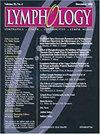脂水肿患者临床表现和骨科改变的患病率:一项前瞻性队列研究。
IF 0.7
4区 医学
Q4 IMMUNOLOGY
引用次数: 6
摘要
脂肪水肿是一种常见于女性的慢性疾病,可引起下肢异常脂肪沉积,并伴有瘀伤和疼痛。尽管关于脂水肿的知识越来越多,但仍有诊断方面需要进一步研究。我们进行了一项前瞻性、观察性队列研究,以描述脂肪水肿患者的临床特征,试图建立诊断标准。参与者是2012年9月至2019年12月在西班牙一家公立医院连续就诊的脂水肿患者。检查患者的以下体征和症状脂水肿:对称受累;上半身和下半身不相称;少用脚;疼痛;瘀伤;除梗器的标志;点蚀测试;肝纤维化;静脉功能不全;上肢受累;血管蜘蛛;皮肤寒冷;淋巴管炎发作。此外,对所有患者进行骨科改变检查。我们招募了138例患者(中位年龄=47.6岁;平均BMI=29.9 Kg/m2)。腰高比显示,41.3%的患者身材苗条或健康。最常见的脂肪水肿类型是III型(71%),大多数是在1期和2期。患病率为80%的脂水肿的特征是对称受累、足部未受影响、疼痛、瘀伤、血管蜘蛛和比例失调。痛觉性疼痛占60.2%,神经性疼痛占33.1%,社交或工作活动减少占37.9%。在1/3的患者中观察到包括足凹或膝外翻在内的骨科改变。63例患者行膝关节x线检查,37例诊断为膝关节骨性关节炎。我们发现脂水肿最常见的表现是双侧受累,足部未受影响,疼痛,易瘀伤,血管蜘蛛,以及身体上下部分不比例。这些应被视为诊断的主要标准。此外,我们关于脂肪水肿患者骨科改变患病率的研究结果强调了多学科综合治疗方法的必要性。本文章由计算机程序翻译,如有差异,请以英文原文为准。
Prevalence of clinical manifestations and orthopedic alterations in patients with lipedema: A prospective cohort study.
Lipedema is a chronic disease seen frequently in women that causes abnormal fat deposition in the lower limbs and associated bruising and pain. Despite increasing knowledge concerning lipedema, there are still aspects of diagnosis that need further investigation. We performed a prospective, observational cohort study to describe prevalence of clinical characteristics present in patients with lipedema in an attempt to establish diagnostic criteria. Participants were consecutive patients with lipedema presenting at a public hospital in Spain from September 2012 to December 2019. Patients were examined for the following signs and symptoms of lipedema: symmetrical involvement; disproportion between the upper and lower part of the body; sparing of the feet; pain; bruising; Stemmer' sign; pitting test; fibrosis; venous insufficiency; upper limbs involvement; vascular spiders; skin coldness; and lymphangitis attacks. In addition, orthopedic alterations were examined in all patients. We recruited 138 patients (median age=47.6 years; mean BMI=29.9 Kg/m2). Using waist-to-height-ratio, 41.3% of the patients were slim or healthy. The most frequent type of lipedema was Type III (71%), and most were in stage 1 and 2. The features of lipedema with a prevalence >80% were symmetrical involvement, unaffected feet, pain, bruising, vascular spiders, and disproportion. Pain was nociceptive in 60.2% and neuropathic in 33.1%, and there was a reduced social or working activities in 37.9%. Orthopedic alterations including cavusfeet or valgus-knees were observed in 1/3 of the patients. X-ray of the knees was performed in 63 patients and knee osteoarthritis diagnosed in 37. We found that the most frequent manifestations of lipedema were bilateral involvement, unaffected feet, pain, easy bruising, vascular spiders, and disproportion between the upper and lower parts of the body. These should be considered as major criteria for diagnosis. In addition, our findings on the prevalence of orthopedic alterations in patients with lipedema highlights the need for a multidisciplinary and integrated approach.
求助全文
通过发布文献求助,成功后即可免费获取论文全文。
去求助
来源期刊

Lymphology
医学-免疫学
CiteScore
5.20
自引率
8.00%
发文量
29
审稿时长
3 months
期刊介绍:
The Journal contains original articles, special features (see below), and information regarding the International Society of Lymphology. It seeks original papers dealing with clinical and basic studies of the lymphatic system and its disorders including related fields. Articles are accepted for external review and publication on the condition that they are contributed to Lymphology only and that no substantial part has been or will be published elsewhere.
 求助内容:
求助内容: 应助结果提醒方式:
应助结果提醒方式:


